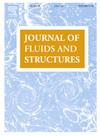结构水下倒塌释放能量耗散的新策略
IF 3.5
2区 工程技术
Q1 ENGINEERING, MECHANICAL
引用次数: 0
摘要
为减轻压力脉冲,对带冠圆柱壳的水下坍塌进行了实验研究。每个实验都涉及一个薄壁金属罩,上面有几个小穿孔,这些小孔与一个密封的可内爆体积同心,在压力容器中以流体静力学的方式使其不稳定。高速立体摄影结合三维数字图像相关(DIC)提供了事件期间裹尸布的全场位移历史。高频响应动态压力传感器放置在几个位置周围的防护罩捕获发射的压力历史。实验研究了不同射孔密度和射孔方向对金属薄圆柱壳内爆压力特征的影响。护罩将排放压力历史降低了90%。研究人员观察到两种翼盖行为,其中一种是通过翼盖壁变形来平衡可内爆欠压,另一种是通过流体通过翼盖射孔进入来平衡。射孔密度直接决定了这两种机制的作用。研究人员正在研究内爆体与可变形围壳之间的流固相互作用以及冲量缓解优化。本文章由计算机程序翻译,如有差异,请以英文原文为准。
Novel strategy for dissipating energy released from underwater collapse of structures
An experimental study of the underwater collapse of shrouded cylindrical shells was conducted to mitigate the pressure pulses emitted. Each experiment involved a thin-walled metallic shroud with several small perforations placed concentric to a sealed implodable volume, which was brought to instability hydrostatically within a pressure vessel. High-speed stereo photography coupled with 3D digital image correlation (DIC) provided full-field displacement histories of the shroud during the event. High frequency response dynamic pressure transducers placed at several locations around the shroud captured emitted pressure histories. The effects of varying perforation densities and perforation orientation of shrouds on the pressure signatures emitted by the implosion of thin metallic cylindrical shells were experimentally investigated. The shrouds mitigated the emitted pressure history by up to 90%. Two regimes of shroud behavior were observed, one in which the implodable underpressure is equalized primarily by shroud wall deformation and one where equalization occurs through fluid ingression via the shroud perforations. The perforation density directly determined the contribution from both of those two mechanisms. Research is ongoing to understand the fluid-structure interaction between an imploding volume and a deformable confining shroud along with impulse mitigation optimization.
求助全文
通过发布文献求助,成功后即可免费获取论文全文。
去求助
来源期刊

Journal of Fluids and Structures
工程技术-工程:机械
CiteScore
6.90
自引率
8.30%
发文量
173
审稿时长
65 days
期刊介绍:
The Journal of Fluids and Structures serves as a focal point and a forum for the exchange of ideas, for the many kinds of specialists and practitioners concerned with fluid–structure interactions and the dynamics of systems related thereto, in any field. One of its aims is to foster the cross–fertilization of ideas, methods and techniques in the various disciplines involved.
The journal publishes papers that present original and significant contributions on all aspects of the mechanical interactions between fluids and solids, regardless of scale.
 求助内容:
求助内容: 应助结果提醒方式:
应助结果提醒方式:


